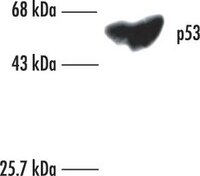OP43 Sigma-AldrichAnti-p53 (Ab-6) (Pantropic) Mouse mAb (DO-1)
This Anti-p53 (Ab-6) (Pantropic) Mouse mAb (DO-1) is validated for use in Frozen sections, Immunoblotting, ICC, IP, Paraffin sections for the detection of p53 (Ab-6) (Pantropic).
More>> This Anti-p53 (Ab-6) (Pantropic) Mouse mAb (DO-1) is validated for use in Frozen sections, Immunoblotting, ICC, IP, Paraffin sections for the detection of p53 (Ab-6) (Pantropic). Less<<Prodotti consigliati
Panoramica
| Replacement Information |
|---|
Tabella delle specifiche principali
| Species Reactivity | Host | Antibody Type |
|---|---|---|
| Fe, H | M | Monoclonal Antibody |
Prezzi e disponibilità
| Numero di catalogo | Disponibilità | Confezionamento | Qtà/conf | Prezzo | Quantità | |
|---|---|---|---|---|---|---|
| OP43-100UG |
|
Fiala di plastica | 100 μg |
|
— | |
| OP43-20UG |
|
Fiala di plastica | 20 μg |
|
— |
| Product Information | |
|---|---|
| Form | Liquid |
| Formulation | In 0.05 M sodium phosphate buffer, 0.2% gelatin. |
| Negative control | SK-OV-3 cells or normal skin tissue |
| Positive control | A431 cells or breast carcinoma tissue |
| Preservative | ≤0.1% sodium azide |
| Quality Level | MQ100 |
| Physicochemical Information |
|---|
| Dimensions |
|---|
| Materials Information |
|---|
| Toxicological Information |
|---|
| Safety Information according to GHS |
|---|
| Safety Information |
|---|
| Product Usage Statements |
|---|
| Storage and Shipping Information | |
|---|---|
| Ship Code | Blue Ice Only |
| Toxicity | Standard Handling |
| Storage | +2°C to +8°C |
| Do not freeze | Yes |
| Packaging Information |
|---|
| Transport Information |
|---|
| Supplemental Information |
|---|
| Specifications |
|---|
| Global Trade Item Number | |
|---|---|
| Numero di catalogo | GTIN |
| OP43-100UG | 04055977227543 |
| OP43-20UG | 04055977227123 |
Documentation
Anti-p53 (Ab-6) (Pantropic) Mouse mAb (DO-1) Certificati d'Analisi
| Titolo | Numero di lotto |
|---|---|
| OP43 |
Riferimenti bibliografici
| Panoramica delle referenze |
|---|
| El-Deiry, W.S., et al. 1994. Cancer Res. 54, 1169. Greenblatt, M.S., et al. 1994. Cancer Res. 54, 4855. Legros, Y., et al. 1994. Oncogene 9, 2071. Barak, Y., et al. 1993. EMBO J. 12, 461. Kastan, M.B., et al. 1992. Cell 71, 587. Kuerbitz, S.J. 1992. Proc. Natl. Acad. Sci. USA 89, 7491. Lane, D.P. 1992. Nature 358, 15. Vojtesek, B., et al. 1992. J. Immunol. Meth. 151, 237. Kastan, M.B., et al. 1991 Cancer Res. 51, 6304. |
Brochure
| Titolo |
|---|
| Caspases and other Apoptosis Related Tools Brochure |
Citazioni
| Titolo | |
|---|---|
|
|
| Scheda tecnica | ||||||||||||||||||||||||||||||||||||||||||||||||||
|---|---|---|---|---|---|---|---|---|---|---|---|---|---|---|---|---|---|---|---|---|---|---|---|---|---|---|---|---|---|---|---|---|---|---|---|---|---|---|---|---|---|---|---|---|---|---|---|---|---|---|
|
Note that this data sheet is not lot-specific and is representative of the current specifications for this product. Please consult the vial label and the certificate of analysis for information on specific lots. Also note that shipping conditions may differ from storage conditions.
|








